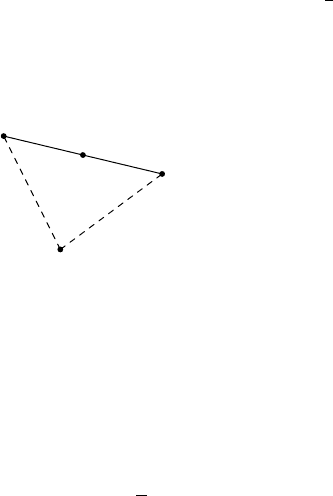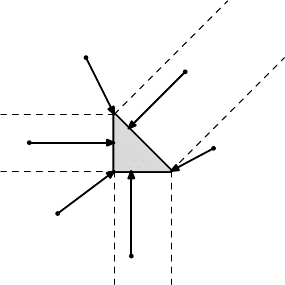Davidson K.R., Donsig A.P. Real Analysis with Real Applications
Подождите немного. Документ загружается.


16.1 Convex Sets 563
F. Suppose that A is a convex subset of R
n
and that T is a linear transformation from R
n
into R
m
. Prove that T A is convex and aff(TA) = T aff(A).
G. If A ⊂ R
m
and B ⊂ R
n
, then A × B := {(a, b) ∈ R
m+n
: a ∈ A, b ∈ B}. Show
that conv(A × B) = conv(A) × conv(B).
H. (a) If S is a bounded subset of R
n
, prove that conv(S) is bounded.
(b) Give an example of a closed subset S of R
2
such that conv(S) is not closed.
I. Recall that the graph of f : R
n
→ R
m
is G(f) = {(x, y) ∈ R
n
× R
m
: f(x) = y}.
Show that f is a linear function if and only if G(f) is a linear subspace of R
m+n
and
f is an affine function if and only if G(f) is an affine set.
J. A function f on R is convex if f
¡
λx + (1 − λ)y
¢
≤ λf (x) + (1 − λ)f(y) for all
x, y ∈ R and 0 ≤ λ ≤ 1. If f is any function on R, define the epigraph of f to be
epi(f) = {(x, y) ∈ R
2
: y ≥ f(x)}. Show that f is a convex function if and only if
epi(f) is a convex subset of R
2
.
K. Let A and B be convex subsets of R
n
. Prove that conv(A ∪B) equals the union of all
line segments [a, b] such that a ∈ A and b ∈ B.
L. The asymptotic cone. Let A ⊂ R
n
be closed and convex, and x ∈ A.
(a) Show that s(A − x) ⊂ t(A − x) if 0 < s < t.
(b) Show that A
∞
(x) =
T
t>0
t(A − x) := {d : x + td ∈ A for all t > 0} is a cone.
(c) Show that A
∞
(x) does not depend on the point x.
HINT: Consider (1 −
1
k
)y +
1
k
(x + ktd).
(d) Prove that A is compact if and only if A
∞
= {0}.
HINT: If ka
k
k → ∞, find a cluster point d of a
k
/ka
k
k. Argue as in (c).
M. A set S ⊂ R
n
is a star-shaped set with respect to v ∈ S if [s, v] ⊂ S for all s ∈ S.
(a) Show that S is convex if and only if it is star shaped with respect to every v ∈ S.
(b) Find a set that is star shaped with respect to exactly one of its points.
N. (a) Given a sequence of convex sets B
1
⊂ B
2
⊂ B
3
··· in R
n
, show that
S
i≥1
B
i
is
convex.
(b) For any sequence of convex sets B
1
, B
2
, B
3
, . . . in R
n
, show that
S
j≥1
(
T
i≥j
B
i
)
is convex.
O. A set S ⊂ R
n
is called affinely dependent if there is an s ∈ S so that s ∈ aff(S\{s}).
Show that S is affinely dependent if and only if there are distinct elements s
1
, . . . , s
r
of S and scalars µ
1
, . . . , µ
r
, not all zero, so that
P
r
i=1
µ
i
s
i
= 0 and
P
r
i=1
µ
i
= 0.
HINT: Solve for some s
i
.
P. A subset S ⊂ R
n
is affinely independent if it is not affinely dependent. Show that an
affinely independent set in R
n
can have at most n + 1 points.
HINT: If {s
0
, . . . , s
n
} ⊂ S, show that {s
i
− s
0
: 1 ≤ i ≤ n} is linearly independent.
Q. Radon’s Theorem. Suppose that s
1
, . . . , s
r
are distinct points in R
n
, with r > n + 1.
Show that there are disjoint sets I and J with I ∪ J = {1, . . . , r} so that the convex
sets conv{s
i
: i ∈ I} and conv{s
j
: j ∈ J} have nonempty intersection.
HINT: Use the previous two exercises to obtain 0 as a nontrivial linear combination of
these elements. Then consider those elements with positivecoefficients in this formula.

564 Convexity and Optimization
R. Helly’s Theorem. Let C
k
be convex subsets of R
n
for 1 ≤ k ≤ m. Suppose that any
n + 1 of these sets have nonempty intersection. Prove that the whole collection has
nonempty intersection.
HINT: Use induction on m ≥ n+1 sets. If true for m−1, choose x
j
in the intersection
of C
1
, . . . , C
j−1
, C
j+1
, . . . , C
m
. Apply Radon’s Theorem.
16.2. Relative Interior
In workingwith a convex subset A of R
n
, the natural space containing it is often
aff(A), not R
n
, which may be far too large. The affine hull is a better place to work
for many purposes. Indeed, if A is a convex subset of R
n
with dimA = k < n,
then thinking of A simply as a subset of aff(A), which may be identified with R
k
,
allows us to talk more meaningfully about topological notions such as interior and
boundary. One sign that the usual interior is not useful is Exercise 16.1.D, which
shows that A has empty interior when dim(A) < n. This section is devoted to
developing the properties of the interior relative to aff(A).
16.2.1. DEFINITION. If A is a convex subset of R
n
, then the relative interior
of A, denoted ri(A), is the interior of A relative to aff(A). That is, a ∈ ri(A) if and
only if there is an ε > 0 so that B
ε
(a) ∩ aff(A) ⊂ A.
Define the relative boundary of A, denoted rbd(A), to be
A \ ri(A).
16.2.2. EXAMPLE. If dimA = k < n, then ri(A) is the interior of A when
A is considered as a subset of aff(A), which is identified with R
k
. For example,
consider the closed convex disk A = {(x, y, z) ∈ R
3
: x
2
+ y
2
≤ 1, z = 0}.
Then aff(A) = {(x, y, z) ∈ R
3
: z = 0} is a plane. The relative interior of A is
ri(A) = {(x, y, z) ∈ R
3
: x
2
+ y
2
< 1, z = 0}, the interior of the disk in this
plane, while the interior as a subset of R
3
is empty. The relative boundary is the
circle {(x, y, z) ∈ R
3
: x
2
+ y
2
= 1, z = 0}.
Notice that A ⊂ B does not imply that ri(A) ⊂ ri(B) because an increase in
dimension can occur. For example, let B = {(x, y, z) : x
2
+ y
2
≤ 1, z ≤ 0}. Then
ri(B) = int(B) = {(x, y, z) : x
2
+ y
2
< 1, z < 0}. So A ⊂ B but ri(A) and ri(B)
are disjoint.
The following result shows that the phenomenon above occurs precisely be-
cause of the dimension shift. Despite its trivial proof, it will be quite useful.
16.2.3. LEMMA. Suppose that A and B are convex subsets of R
n
with A ⊂ B.
If aff(A) = aff(B), then ri(A) ⊂ ri(B).
PROOF. If a ∈ ri(A), then there is an ε > 0 with B
ε
(a) ∩ aff(A) ⊂ A. Because
aff(B) = aff(A), we have B
ε
(a) ∩ aff(B) ⊂ A ⊂ B, so a ∈ ri(B). ¥
16.2 Relative Interior 565
A polytope is the convex hull of a finite set. Now we obtain an analogue of
Theorem 16.1.7 describing the relative interior of a polytope.
16.2.4. LEMMA. Let S = {s
1
, . . . , s
r
} be a finite subset of R
n
. Then
ri
¡
conv(S)
¢
=
½
r
X
i=1
λ
i
s
i
: λ
i
∈ (0, 1),
r
X
i=1
λ
i
= 1
¾
.
PROOF. By Theorem 16.1.7, conv(S) =
©
P
i
λ
i
s
i
: λ
i
∈ [0, 1],
P
i
λ
i
= 1
ª
. The
subspace L(S) is given by Exercise 16.1.E as L(S) =
©
P
i
λ
i
s
i
:
P
i
λ
i
= 0
ª
.
Let e
1
, . . . , e
k
be an orthonormal basis for L(S). Express each e
j
as a com-
bination e
j
=
P
i
λ
ij
s
i
, where
P
i
λ
ij
= 0, and define Λ = max
i
¡
P
j
λ
2
ij
¢
1/2
.
Suppose that x is vector in L(S). Then
x =
k
X
j=1
x
j
e
j
=
r
X
i=1
³
k
X
j=1
λ
ij
x
j
´
s
i
.
By the Schwarz inequality (4.1.1),
¯
¯
¯
k
X
j=1
λ
ij
x
j
¯
¯
¯
≤
³
k
X
j=1
λ
2
ij
´
1/2
³
k
X
j=1
x
2
j
´
1/2
≤ Λkxk.
Thus if kxk < ε/Λ, then x may be expressed as x =
P
i
µ
i
s
i
, where
P
i
µ
i
= 0
and |µ
i
| < ε for 1 ≤ i ≤ r.
Let a =
P
i
λ
i
s
i
, where λ
i
∈ (0, 1) and
P
i
λ
i
= 1. Then there is an ε > 0 so
that ε ≤ λ
i
≤ 1 − ε for 1 ≤ i ≤ r. Note that
B
ε/Λ
(a) ∩ aff(S) = a +
¡
B
ε/Λ
(0) ∩ L(S)
¢
.
If x ∈ L(S) and kxk < ε/Λ, we use the representation above to see that
a + x =
r
X
i=1
(λ
i
+ µ
i
)s
i
.
Now
P
i
λ
i
+ µ
i
= 1 and λ
i
+ µ
i
∈ [ε, 1−ε] + (−ε, ε) = (0, 1). So a + x belongs
to conv(S). This shows that a belongs to ri(conv(S)).
Conversely, suppose that a ∈ ri(S). Write a =
P
i
λ
i
s
i
, where λ
i
∈ [0, 1] and
P
i
λ
i
= 1. We wish to show that it has a possibly different representation with
coefficients in (0, 1). Let ε > 0 be given so that B
ε/Λ
(a) ∩ aff(S) ⊂ conv(S). If
each λ
i
∈ (0, 1), there is nothing to prove. Suppose that J = {j : λ
j
= 0} is
nonempty, and let k be chosen so that λ
k
> 0. Pick a δ > 0 so small that |J|δ < λ
k
and x = δ
P
j∈J
(s
j
−s
k
) satisfies kxk < ε. Then a ±x belong to conv(S). Write
a − x =
P
i
µ
i
s
i
, where µ
i
∈ [0, 1] and
P
i
µ
i
= 1. Also,
a + x =
X
j∈J
δs
j
+ (λ
k
− |J|δ)s
k
+
X
i∈(J∪{k})
c
λ
i
s
i
=:
r
X
i=1
ν
i
s
i
.

566 Convexity and Optimization
It is evident from our construction that each ν
i
> 0; and since
P
i
ν
i
= 1, all are
less than 1. Now a =
P
i
µ
i
+ ν
i
2
s
i
is expressed with all coefficients in (0, 1). ¥
16.2.5. COROLLARY. If A is a nonempty convex subset of R
n
, then ri(A) is
also nonempty. Moreover, aff(ri(A)) = aff(A).
PROOF. Let k = dimconv(A). Then there is a subset S of k + 1 points so that
aff(S) = aff(A). Indeed, fix any element a
0
∈ A. Since L(A) is spanned by
{a − a
0
: a ∈ A} and has dimension k, we may choose k vectors a
1
, . . . , a
k
in A such that a
i
− a
0
are linearly independent. Clearly, they span L(A). So
S = {a
0
, . . . a
k
} will suffice.
Hence, by Lemma 16.2.3, ri(convA) contains ri(convS). Let a =
1
k+1
k
P
i=0
a
i
.
By Lemma 16.2.4, ri(convS) is nonempty and, in particular, contains the points
b
i
= (a + 2a
i
)/3 and c
i
= (2a + a
i
)/3 for 0 ≤ i ≤ k. So aff(ri(conv S)) contains
2b
i
− c
i
= a
i
for 0 ≤ i ≤ k, whence it equals aff(A) as claimed. ¥
The next theorem will be surprisingly useful. In particular, this theorem applies
if b is in the relative boundary, rbd(A).
16.2.6. ACCESSIBILITY LEMMA.
Suppose that A is a convex subset of R
n
. If a ∈ ri(A) and b ∈
A, then [a, b) is
contained in ri(A).
PROOF. Let ε > 0 be given so that B
ε
(a) ∩ aff(A) ⊂ A. We need to show
that λa + (1 − λ)b ∈ ri(A) for λ ∈ (0, 1). Since b ∈ A, pick c ∈ A so that
x = b − c ∈ L(A) satisfies kxk < ελ/(2 − 2λ). Suppose that z ∈ L(A) with
kzk < ε/2. Then
λa + (1 −λ)b + λz = λa + (1 − λ)(c + x) + λz
= λ(a + z + (1 −λ)x/λ) + (1 − λ)c.
Since kz + (1 − λ)x/λk ≤ kzk + (1 − λ)kxk/λ < ε/2 + ε/2 = ε, this is a
vector in B
ε
(0) ∩ L(A). Hence d = a + z + (1 − λ)x/λ belongs to A. Thus
λa + (1 − λ)b + λz = λd + (1 − λ)c also lies in A. So a + (1 − λ)b belongs to
ri(A). ¥
Applying the preceding result when b ∈ ri(A) shows that ri(A) is convex.
Since int(A) is either the empty set or equal to ri(A), we have the following:
16.2.7. COROLLARY. If A is a convex subset of R
n
, so are ri(A) and int(A).
16.2.8. THEOREM. If A is a convex subset of R
n
, then the three sets ri(A), A,
and A all have the same affine hulls, closures, and relative interiors.

16.2 Relative Interior 567
PROOF. By Corollary 16.2.5, aff(ri(A)) = aff(A). Since the affine hull is closed,
A ⊂ aff(A) and hence aff(A) = aff(A).
Now ri(A) ⊂ A ⊂ A, and so ri(A) ⊂ A = A, where the equality follows from
Proposition 4.3.5. Suppose that b ∈ A. By Corollary 16.2.5, ri(A) contains a point
a. Hence by the Accessibility Lemma (Lemma 16.2.6), λa + (1 − λ)b belongs to
ri(A) for 0 < λ ≤ 1. Letting λ tend to 0 shows that b ∈
ri(A). Thus ri(A) = A.
For relative interiors, first observe that since the three sets have the same affine
hull, Lemma 16.2.3 shows ri(ri(A)) ⊂ ri(A) ⊂ ri(A). Now ri(ri(A)) = ri(A). For
if a ∈ ri(A) and x ∈ B
ε
(a) ∩ aff(A) ⊂ A, then using r = ε − kx − ak > 0,
it follows that B
r
(x) ∩ aff(A) ⊂ B
ε
(a) ∩ aff(A) ⊂ A. Hence B
ε
(a) ∩ aff(A) is
contained in ri(A) and so a ∈ ri(ri(A)).
Suppose that a ∈ ri(
A). Then there is an ε > 0 so that B
ε
(a) ∩ aff(A) ⊂ A.
Pick anyb ∈ ri(A), and set x = (a−b)/ka−bk. Then c
±
= a±εx belong to A. But
c
−
= (1 −ε)a + εb ∈ ri(A) by the Accessibility Lemma. Hence a = (c
+
+ c
−
)/2
belongs to ri(A), again by the Accessibility Lemma. Therefore, ri(A) = ri(A). ¥
The next two results will allow us to conveniently compute various combina-
tions of convex sets such as sums and differences. The first is quite straightforward
and is left as an exercise.
16.2.9. PROPOSITION. If A ⊂ R
n
and B ⊂ R
m
are convex sets, then A × B
is convex, ri(A × B) = ri(A) × ri(B) and aff(A × B) = aff(A) × aff(B).
16.2.10. THEOREM. If A is a convex subset of R
m
and T is a linear map from
R
m
to R
n
, then T ri(A) = ri(T A).
PROOF. By Exercise 16.1.F, T A is convex. Using Theorem 16.2.8 for the first
equality and the continuity of T (see Corollary 5.1.7) for the second containment,
we have
T A ⊂ T A = T ri(A) ⊂ T ri(A) ⊂ T A.
Taking closures, we obtain T ri(A) = T A. Using Theorem 16.2.8 again,
ri(T A) = ri(T A) = ri(T ri(A)) = ri(T ri(A)) ⊂ T ri(A).
For the reverse containment, let a ∈ ri(A). We will show that T a lies in
ri(T A). By Corollary 16.2.5, ri(T A) is nonempty. So we may pick b ∈ A with T b
in ri(T A). As a ∈ ri(A), there is an ε > 0 so that c = a + ε(a − b) belongs to A.
But a =
1
1+ε
c +
ε
1+ε
b, so a ∈ [b, c). By linearity, T a lies in [T b, T c). Therefore,
by the Accessibility Lemma (Lemma 16.2.6), T a belongs to ri(T A). ¥
16.2.11. COROLLARY. Suppose that A and B are convex subsets of R
n
. Then
ri(A + B) = ri(A) + ri(B) and ri(A − B) = ri(A) − ri(B).

568 Convexity and Optimization
PROOF. For the two cases, define maps T from R
n
×R
n
to R
n
by T (a, b) = a ±b.
Then T (A × B) = A ± B. By the two previous results,
ri(A ± B) = T ri(A × B) = T (ri(A) × ri(B)) = ri(A) ± ri(B).
¥
Exercises for Section 16.2
A. Write out a careful proof of Proposition 16.2.9.
B. Explain why the notion of relative closure of a convex set isn’t needed.
C. Let C be a convex subset of R
n
and let U be an open set that intersects C. Show that
U ∩ ri(C) is nonempty.
D. Suppose that a convex subset A of R
n
intersects every (affine) line in a closed interval.
Show that A is closed. HINT: Connect b ∈
A to a in ri(A).
E. Let A be a convex subset of R
n
that is dense in aff(A). Prove that A = aff(A).
F. Let A be a convex subset of R
n
. Show that if B is a compact subset of ri(A), then
conv(B) is a compact convex subset of ri(A). HINT: Corollary 16.1.9
G. (a) Show that if A and B are closed convex sets and A is compact, then A + B is a
closed convex set.
(b) If B is also compact, show that A + B is compact.
(c) Give an example of two closed convex sets with nonclosed sum.
HINT: Look for two closed convex subsets of R
2
that lie strictly above the x-axis
but 0 is a limit point of A + B.
H. Suppose that C and D are convex subsets of R
n
and that C ⊂ D. Show that if
ri(D) ∩ C is nonempty, then ri(C) ⊂ ri(D).
HINT: If d ∈ ri(D) ∩ C and c ∈ ri(C), extend [d, c] beyond c.
I. Suppose that A and B are convex subsets of R
n
with ri(A) ∩ ri(B) 6= ∅.
(a) Show that A ∩ B = A ∩ B. HINT: Connect b ∈ A ∩ B to a ∈ ri(A) ∩ ri(B).
(b) Show that ri(A ∩ B) = ri(A) ∩ ri(B).
16.3. Separation Theorems
The goal of this section is show that we can separate two disjoint convex sets
from one another by a hyperplane. Geometrically, it seems obvious that, given a
convex set A ⊂ R
2
and b /∈ A, there is a line that separates b from A. The appro-
priate generalization (replacing the line with a hyperplane) is true in R
n
. Indeed,
there is a general form of this theorem, called the Hahn–Banach theorem, which
holds for any normed vector space. We prove this result for R
n
, where we can use
the Heine–Borel Theorem (Theorem 4.4.6).
We start by showing that a convex set in R
n
always has a unique closest point
to a given point outside. The existence of such a point comes from Exercise 5.4.J
for any closed set and does not require convexity. In convexity theory, the map to

16.3 Separation Theorems 569
this closest point is called a projection, which differs from the meaning of the term
in linear algebra.
16.3.1. CONVEX PROJECTION THEOREM.
Let A be a nonempty closed convex subset of R
n
. For each point x ∈ R
n
, there is
a unique point P
A
(x) in A which is closest to x. The point P
A
(x) is characterized
by
x − P
A
(x), a − P
A
(x)
®
≤ 0 for all a ∈ A.
Moreover, kP
A
(x) − P
A
(y)k ≤ kx − yk for all x, y ∈ R
n
.
Geometrically, the equation says that the line segment [x, P
A
(x)] makes an
obtuse angle with [a, P
A
(x)] for every point a ∈ A. The last estimate shows that
P
A
has Lipschitz constant 1 and, in particular, is continuous.
PROOF. Pick any vector a
0
in A, and let R = kx − a
0
k. Then
0 ≤ inf{kx − ak : a ∈ A} ≤ R.
The closest point to x in A must belong to A∩B
R
(x). This is the intersection of two
closed convex sets, and so is closed and convex. Moreover, A ∩B
R
(x) is bounded
and thus compact by the Heine–Borel Theorem (Theorem 4.4.6). Consider the
continuous function on A ∩ B
R
(x) given by f(a) = kx − ak. By the Extreme
Value Theorem (Theorem 5.4.4), there is a point a
1
∈ A at which f takes its
minimum—a closest point.
To see that a
1
is unique, we need to use convexity. Suppose that there is another
vector a
2
∈ A with kx − a
2
k = kx − a
1
k. We will show that b =
1
2
(a
1
+ a
2
) is
closer, contradicting the choice of a
1
as a closest point. See Figure 16.2. One way
to accomplish this is to apply the parallelogram law (see Exercise 16.3.A). Instead,
we give an elementary argument using Euclidean geometry.
x
a
1
a
2
b
FIGURE 16.2. The points x, a
1
, a
2
, and b.
Consider the triangle with vertices x, a
1
, and a
2
. As kx − a
1
k = kx − a
2
k,
this triangle is isosceles. As kb − a
1
k = kb − a
2
k, the point b is the foot of the
perpendicular dropped from x to [a
1
, a
2
] and therefore kx−bk < kx−a
i
k. Indeed,
∠xba
i
is a right angle, and the Pythagorean Theorem shows that
kx − a
i
k
2
= kx − bk
2
+
1
4
ka
1
− a
2
k
2
.

570 Convexity and Optimization
It now makes sense to define the function P
A
by setting it to be this unique
closest point to x. Let a 6= P
A
(x) be any other point in A. Then for 0 < λ ≤ 1,
kx − a
1
k
2
< kx − (λa + (1 − λ)a
1
)k
2
= k(x − a
1
) − λ(a − a
1
)k
2
= kx − a
1
k
2
− 2λhx − a
1
, a − a
1
i + λ
2
ka − a
1
k
2
so that hx−a
1
, a−a
1
i ≤
λ
2
ka−a
1
k
2
. Let λ tend to 0 to obtain hx−a
1
, a−a
1
i ≤ 0.
This argument is reversible. If a
1
is any point such that hx − a
1
, a − a
1
i ≤ 0
for all a ∈ A, then
kx − ak
2
= kx − a
1
k
2
− 2hx − a
1
, a − a
1
i + ka − a
1
k
2
≥ kx − a
1
k
2
+ ka − a
1
k
2
.
Hence a
1
= P
A
(x) is the unique closest point.
Let x and y be points in R
n
. Apply the inequality once for each of x and y:
x − P
A
(x), P
A
(y) − P
A
(x)
®
≤ 0
and
P
A
(y) − y, P
A
(y) − P
A
(x)
®
=
y − P
A
(y), P
A
(x) − P
A
(y)
®
≤ 0.
Adding yields h(x − y) + (P
A
(y) − P
A
(x)), P
A
(y) − P
A
(x)i ≤ 0. Hence
kP
A
(y) − P
A
(x)k
2
≤
y − x, P
A
(y) − P
A
(x)
®
≤ ky − xkkP
A
(y) − P
A
(x)k
by the Schwarz inequality (4.1.1). Therefore, kP
A
(y) − P
A
(x)k ≤ kx − yk. ¥
16.3.2. EXAMPLE. Let A be the triangle in R
2
with vertices (0, 0), (1, 0), and
(0, 1) as in Figure 16.3. Then
P
A
((x, y)) =
(x, y) if (x, y) ∈ A
(x, 0) if 0 ≤ x ≤ 1 and y ≤ 0
(0, y) if 0 ≤ y ≤ 1 and x ≤ 0
(0, 0) if x ≤ 0 and y ≤ 0
(1, 0) if x ≥ 1 and y ≤ 0
(1, 0) if 0 ≤ y ≤ x − 1
(0, 1) if y ≥ 1 and x ≤ 0
(0, 1) if 0 ≤ x ≤ y − 1
(s, 1 − s) if x + y ≥ 1 and |y − x| ≤ 1, where s =
y+1−x
2
.
We can now prove the promised separation theorem, which will be fundamental
to all of our later work. We provide only two consequences in this section. There
are many more.

16.3 Separation Theorems 571
A
FIGURE 16.3. The triangle A and action of P
A
.
16.3.3. SEPARATION THEOREM.
Suppose that A is a closed convex set in R
n
and b /∈ A. Then there is a vector
h ∈ R
n
and scalar α ∈ R so that ha, hi ≤ α for all a ∈ A but hb, hi > α. In
particular, h determines a hyperplane H so that A is contained in H
−
and b is
contained in the interior of H
+
.
PROOF. Let a
1
= P
A
(b). As b /∈ A, h = b − a
1
is a nonzero vector. Define
α = ha
1
, hi, and let H = {x : hx, hi = α}. By Theorem 16.3.1, if a ∈ A,
then hb − a
1
, a − a
1
i ≤ 0. Rewriting this, we obtain ha, hi ≤ ha
1
, hi = α.
Therefore, A is contained in H
−
= {x ∈ R
n
: hx, hi ≤ α}. On the other hand,
hb − a
1
, b − a
1
i = khk
2
> 0, which implies that hb, hi > ha
1
, hi = α. ¥
16.3.4. COROLLARY. Let A be a closed convex subset of R
n
. Then b belongs
to A if and only if hb, xi ≤ sup{ha, xi : a ∈ A} for all x ∈ R
n
.
PROOF. If b ∈ A, then the inequality is immediate. For the other direction, suppose
that b /∈ A. Take x to be the vector h given by the Separation Theorem,
hb, hi > α ≥ ha, hi for all a ∈ A.
Thus sup{ha, xi : a ∈ A} ≤ α < hb, hi. Therefore, the inequality of the corollary
is valid precisely for b ∈ A. ¥
This corollary has a beautiful geometric meaning. The proof is left as Exer-
cise 16.3.E.
16.3.5. COROLLARY. A closed convex set in R
n
is the intersection of all the
closed half-spaces that contain it.

572 Convexity and Optimization
16.3.6. DEFINITION. Let A be a closed convex subset of R
n
and b ∈ rbd(A).
A supporting hyperplane to A at b is a hyperplane H so that b ∈ H and A is
contained in one of the closed half-spaces determined by H.
If aff(A) is a proper subspace of R
n
, then it is contained in a hyperplane that
supports A. We regard this as a pathological situation and call H a nontrivial
supporting hyperplane if it does not contain aff(A).
16.3.7. SUPPORT THEOREM.
Let A be a convex subset of R
n
and b ∈ rbd(A). Then there is a nontrivial sup-
porting hyperplane to A at b.
PROOF. We may suppose that A is closed by replacing A with
A. Let a
0
be any
point in ri(A). By the Accessibility Lemma (Lemma 16.2.6), the interval [a
0
, b) is
contained in ri(A). By the same token, the point b
k
:= b +
1
k
(b − a
0
) is not in A
for k ≥ 1, as that would put b into ri(A). Let h
k
= (b
k
−P
A
b
k
)/kb
k
−P
A
b
k
k. The
proof of the Separation Theorem (Theorem 16.3.3) shows that
ha, h
k
i ≤ α
k
:= hP
A
b
k
, h
k
i < hb
k
, h
k
i for all a ∈ A.
By the Heine–Borel Theorem (Theorem 4.4.6), the unit sphere of R
n
is com-
pact. Thus the sequence {h
k
: k ≥ 1} has a convergent subsequence (h
k
i
)
∞
i=1
with
limit h = lim
i→∞
h
k
i
. Then since P
A
is continuous,
lim
i→∞
α
k
i
= lim
i→∞
hP
A
b
k
i
, h
k
i
i = hP
A
b, hi = hb, hi =: α.
If a ∈ A, then
ha, hi = lim
i→∞
ha, h
k
i
i ≤ lim
i→∞
α
k
i
= α.
So A is contained in the half-space H
−
= {x : hx, hi ≤ α}.
The vectors h
k
all lie in the subspace L(A), and thus so does h. Consequently,
b + h belongs to aff(A). Since hb + h, hi = α + 1 > α, it follows that H does not
contain aff(A). So H is a nontrivial supporting hyperplane. ¥
Exercises for Section 16.3
A. Use the parallelogram law (Exercise 7.4.A) to give a different proof of the uniqueness
portion of Theorem 16.3.1.
B. Let A =
B
r
(a). Find an explicit formula for P
A
(x).
C. If A = B
r
(a) and b ∈ rbd(A), show that the unique supporting hyperplane to A at b
is H = {x : hx − a, b − ai = r
2
}.
D. Let A be a subspace. Show that P
A
(x) is the (linear) orthogonal projection onto A.
E. Show that a closed convex set in R
n
is the intersection of all the closed half-spaces
that contain it.
F. Let A ⊂ R
n
be a nonempty open convex set. Show that a ∈ A if and only if for each
hyperplane H of R
n
containing a, the two open half-spaces int H
+
and intH
−
both
contain elements of A.
